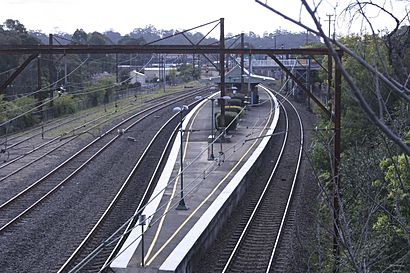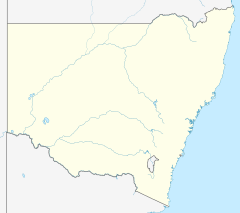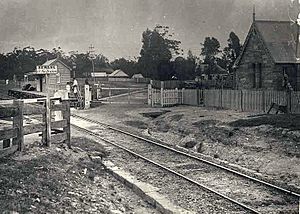Valley Heights railway station facts for kids
Quick facts for kids
Valley Heights
|
|||||||||||
|---|---|---|---|---|---|---|---|---|---|---|---|

Westbound view in August 2009
|
|||||||||||
| Location | Great Western Highway, Valley Heights Australia |
||||||||||
| Coordinates | 33°42′16″S 150°35′02″E / 33.704541°S 150.583876°E | ||||||||||
| Elevation | 324 metres (1,063 ft) | ||||||||||
| Owned by | Transport Asset Holding Entity | ||||||||||
| Operated by | NSW TrainLink | ||||||||||
| Line(s) | Main Western | ||||||||||
| Distance | 77.41 km (48.10 mi) from Central | ||||||||||
| Platforms | 2 (1 island) | ||||||||||
| Tracks | 2 | ||||||||||
| Connections | Bus | ||||||||||
| Construction | |||||||||||
| Structure type | Ground | ||||||||||
| Other information | |||||||||||
| Station code | VHS | ||||||||||
| Website | Transport for NSW | ||||||||||
| History | |||||||||||
| Opened | May 1875 | ||||||||||
| Electrified | February 1957 | ||||||||||
| Previous names | Eagers Platform The Valley |
||||||||||
| Traffic | |||||||||||
| Passengers (2013) | 100 (daily) (Sydney Trains, NSW TrainLink) | ||||||||||
| Rank | 247 | ||||||||||
| Services | |||||||||||
|
|||||||||||
| Official name | Valley Heights Railway Station and Locomotive Depot; The Valley | ||||||||||
| Type | State heritage (complex / group) | ||||||||||
| Designated | 2 April 1999 | ||||||||||
| Reference no. | 1276 | ||||||||||
| Type | Railway Platform/ Station | ||||||||||
| Category | Transport - Rail | ||||||||||
| Builders | NSW Department of Railways | ||||||||||
| Location | |||||||||||
Valley Heights railway station is a historic train station. It is located in Valley Heights, New South Wales, Australia. The station is on the Main Western railway line. It was built by the New South Wales Government Railways. The station is also known as Valley Heights Railway Station and Locomotive Depot or The Valley. It was added to the New South Wales State Heritage Register in 1999. This means it is an important historical site.
Contents
History of Valley Heights Station
The Great Western Railway line reached Valley Heights in 1867. The station platform first opened in May 1875. It was called Eagers Platform. This was to serve the home of a government official, Geoffrey Eager.
In 1877, public facilities were added. The station's name changed to The Valley. On August 19, 1880, it was renamed Valley Heights.
The railway line was made double-track in 1902. At this time, the current brick station building opened. Many stations along the Western line got similar buildings. These were built between 1898 and 1912.
Valley Heights used to have special facilities for trains. Until 1989, it provided extra engines. These engines helped trains climb the steep hills to Katoomba. The line to Valley Heights became electric in 1956. Electric trains took over from steam engines in 1957.
The old train depot is still there. It is now the Valley Heights Locomotive Depot Heritage Museum.
The pedestrian bridge at the station was built in 1901. It was updated in 1992 with a concrete deck. The original gatekeeper's cottage was removed after 1902.
The brick and timber signal box opened in 1913. A bushfire badly damaged it in 1951. The signal box kept working until 1995. Today, it is part of the NSW Rail Transport Museum.
The Valley Heights Locomotive Depot (VHLD) opened in 1914. It became a key railway hub. Assistant engines were attached here for the climb to Katoomba. These engines worked on the longest and steepest main line in Australia.
Many buildings at the depot are from its early days. These include a roundhouse for engines and a turntable. Offices and sidings were also built in 1913.
The depot stopped using steam engines in 1957. Electric engines took over. The depot's role changed. It started servicing electric engines and freight wagons. In 1989, the depot closed down.
In 1994, the Blue Mountains Division of the NSW Rail Transport Museum took over the site. They wanted to save the depot. It is now a museum for the community and visitors.
Trains and Services
Valley Heights station has one island platform. This means trains stop on both sides of a platform. It has two sides for trains.
NSW TrainLink Blue Mountains Line trains stop here. They travel from Sydney Central to Lithgow.
| Platform | Line | Stopping pattern | Notes |
| 1 |
NSW TrainLink
|
services to Sydney Central | |
|---|---|---|---|
| 2 |
NSW TrainLink
|
services to Springwood, Katoomba, Mount Victoria & Lithgow |
What the Station Looks Like
The station area has several important parts. These include the station building, a lamp room, and a signal box. There is also the platform itself and a footbridge.
Station Building (1902)
The main station building is made of brick. It has a metal roof that extends over the platforms. This roof acts like an awning. It has many windows and doors. These have decorative frames and colored glass. The building has two tall chimneys.
Inside, the station building still looks much like it did originally. It has offices, a waiting room, and toilets.
Lamp Room / Store (1902)
This is a small brick shed. It is next to the main station building. It has a metal roof. It was used for lamps and storage.
Signal Box (1910)
The signal box was first built in 1910. It was a three-story building. A fire damaged it in 1951. The top floor collapsed. A new roof was added. The signal box stopped being used in 1994. It is now part of the museum.
Platform (1902)
Valley Heights has an island platform. It is wide in the middle and narrow at the ends. This shape is common for stations in the Blue Mountains. The platform has modern lights, signs, and seats.
Footbridge (1901, 1992)
The footbridge allows people to cross over the tracks. It connects to the street. It was updated in 1992. Most of its parts were replaced then.
What the Train Depot Looks Like
The locomotive depot has many buildings. The most important is the roundhouse. There is also a workshop, offices, and a turntable.
Roundhouse (1913, extended 1973)
The roundhouse is a large building. It has 10 bays where steam engines were kept and serviced. It has a unique peaked roof with a vent at the top. The building is made with timber frames and covered with corrugated iron.
Inside, the floor is made of brick. There are pits where workers could get under the engines. Some pits have been filled in.
Machine Workshop (1973)
This workshop is next to the roundhouse. It is made of timber and corrugated iron. Trains can enter the workshop for repairs. It holds machines like lathes and drills.
Former Offices (1913)
This building used to be an office. It has been restored. It now holds museum displays. It has a simple design with a veranda.
Former Amenities Building (around 1930)
This building used to have locker rooms and meal rooms. It is now a library, museum shop, and display area. It has been expanded over the years.
Turntable (1914, 1967)
The turntable is a large steel circle. It helps move engines onto different tracks. It can also turn engines around. It is still used today. This is the third turntable used at this site.
Ash Disposal Tunnel and Pits (1913)
This underground tunnel was used to remove ash from steam engines. Workers would rake ash into the tunnel. Small trolleys would then take the ash away. This system was used until 1957. The tunnel and tracks are still there.
Other Depot Features
The depot also has old locomotive watering facilities. These include a large water tank. There are also old track sections. Foundations from a former coal plant show how big it was. Overhead poles from 1957 show when electric trains arrived.
Condition of the Buildings
The station building is in good condition. The lamp room is also in good shape. The signal box is in moderate to poor condition. The platform and footbridge are both in good condition.
The locomotive depot is generally in good condition. The museum has worked hard to restore it. The roundhouse has had its roof and windows repaired. The old offices and amenities buildings are in very good condition.
Transport Connections
Blue Mountains Transit runs a bus route from Valley Heights station:
- 690P: From Springwood station to Penrith station
Why Valley Heights is Important (Heritage Listing)
Valley Heights railway station is important for a few reasons:
- History and Technology: It shows how railways were built in the early 1900s. It was part of making the railway line double-track. The station and depot show how trains worked in the past. The roundhouse is very rare in New South Wales. It is one of the oldest and most complete depots built at one time.
- Design and Appearance: The station building is a good example of its architectural style. It looks like other important public buildings from that time. The depot buildings, especially the roundhouse, have a strong industrial look. They show what a busy train hub was like.
- Community Connection: The local community cares a lot about the depot. When the government left the site, people wanted to save it. Now, volunteers run the museum there. This shows how important it is to the community.
- Learning and Research: The depot helps us learn about the "age of steam" trains. It gives valuable information about how trains were serviced. The signal box also helps us understand old signaling systems.




